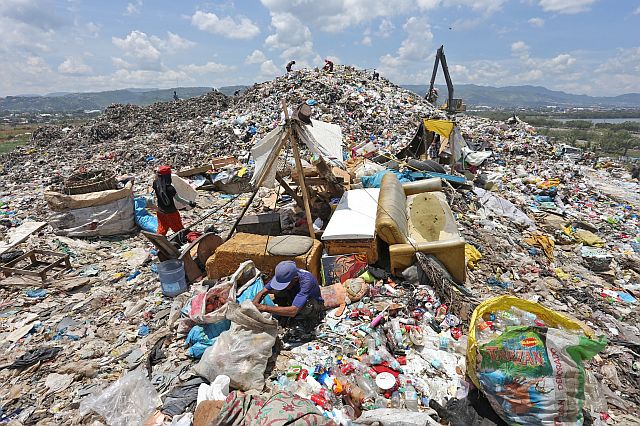
The Movement for a Livable Cebu (MLC), a non-governmental organization composed of concerned Cebuanos, joins calls to close the 15-hectare Inayawan dumpsite that has been the subject of numerous complaints for its dizzying stench that wafted through restaurants, schools and residential buildings in the area (CDN FILE PHOTO)
Next to the Cebu City Council, the Department of Health (DOH) and the Department of Environment and Natural Resources (DENR), comes another group that wants the Cebu City government to stop using its 15-hectare landfill in Barangay Inayawan to dump the city’s garbage.
The group: the Movement for a Livable Cebu (MLC), a non-governmental organization composed of various sectors of concerned Cebuanos.
In a statement released over the weekend, MLC said that they disagreed with most of the statements of Cebu City Mayor Tomas Osmeña regarding the landfill and suggested that the city should instead start looking for short, medium and long-term solutions to the garbage problem.
“The foul odor resulting from the reopening (of the landfill) has a negative effect on tourism. Cebu’s new branding program of ‘Where the Heart Sings’ might as well be ‘Where Cebu stinks,’ the group said in their statement.
“Where the Heart Sings” is Cebu’s tourism brand launched last year following six months of collaboration to identify key elements that capture what Cebu is about.
Partners in the Cebu Brand Team include the Cebu Chamber of Commerce and Industry (CCCI), Mega Cebu, tourism commissions of Cebu City and Cebu province, the Cebu Association of Tour Operators, GMR-Megawide Cebu Airport Corp. and individual volunteers.
According to MLC, the landfill, which was reopened last June, already caused severe negative effects on the economic activities of businesses near the area as well as its tourism.
Among the group’s short-term recommendations was for the city government to renegotiate for “better terms” with a private landfill in Consolacion town used by Cebu City before to dump its garbage.
Sought for comment on MLC’s suggestion, Mayor Osmeña remained adamant on his decision to continue using the landfill in Inayawan instead of paying for the private landfill.
“Why only now? They had six years to negotiate, but they got caught with this anomalous, overpriced situation,” Osmeña said in a text message to Cebu Daily News.
“No bidding no contract deficiencies among others. In the first place, we don’t have enough trucks to haul the trash to Consolacion,” Osmeña added.
The mayor said that many of the trucks bought during the administration of former mayor Michael Rama have already broken down.
The multisectoral volunteer group also suggested that the city should look into a study conducted by the Japan International Cooperation Agency (Jica) on sustainable urban development in Metro Cebu which also has a sub-road map for solid waste management.
MLC added that City Hall should start to initiate a comprehensive solid waste management master plan for Metro Cebu, to which Osmeña replied in his text to CDN: “Let them make a plan. If it makes sense, I may consider. They have been talking and planning for six years. Together, nothing happened!”
Other solutions proposed by the MLC include an enhanced waste reduction and recovery program for the city; an effective management system of medical waste and hazardous waste treatment facilities; and an environmentally sustainable closure of the Inayawan landfill.
MLC said the city should address the different violations of the landfill as pointed out by DENR and DOH.
Earlier this month, the city began to address the DENR-issued violations of the city’s Environmental Compliance Certificate (ECC) by spraying enzymes in the landfill from 9 a.m. to 2 p.m. daily to lessen the foul odor.
City environmental consultant Nida Cabrera said that the enzymes were from “private sectors and partners from Japan” who gave the deodorizers for free while the City Council had yet to decide on budget requests for the landfill.
At least five truckloads of deodorizers will be applied on the landfill daily, Cabrera had said.
Filling materials from the different construction sites in the city had also started to arrive to be used to cover the mounds of garbage.
The filling materials were given by the construction companies voluntarily in place of the limestone that City Hall still needed to purchase in order to eliminate the stench.
Last week, Osmeña and Cabrera visited the landfill and assessed the stench to be “okay” after the measures that were undertaken by the city.
Cabrera was tasked to inform the DENR about the city’s efforts and plans on the 13 violations cited against them.
For medium-term solutions, MLC said the city should initiate the construction of new dumpsites and medical and hazardous waste facilities by 2018.
The city should also review modern systems of collecting, segregating and consolidating remaining solid wastes.
As one of their long-term suggestions, MLC said that by 2025, the city should already start developing waste-to-energy systems.
MLC is a SEC-registered broad-based multisectoral group composed of professionals, youth, religious practitioners, urban poor residents, academia, business owners, property owners, people with disability and other concerned residents of Cebu all hoping to contribute to make Cebu a sustainable and livable community.